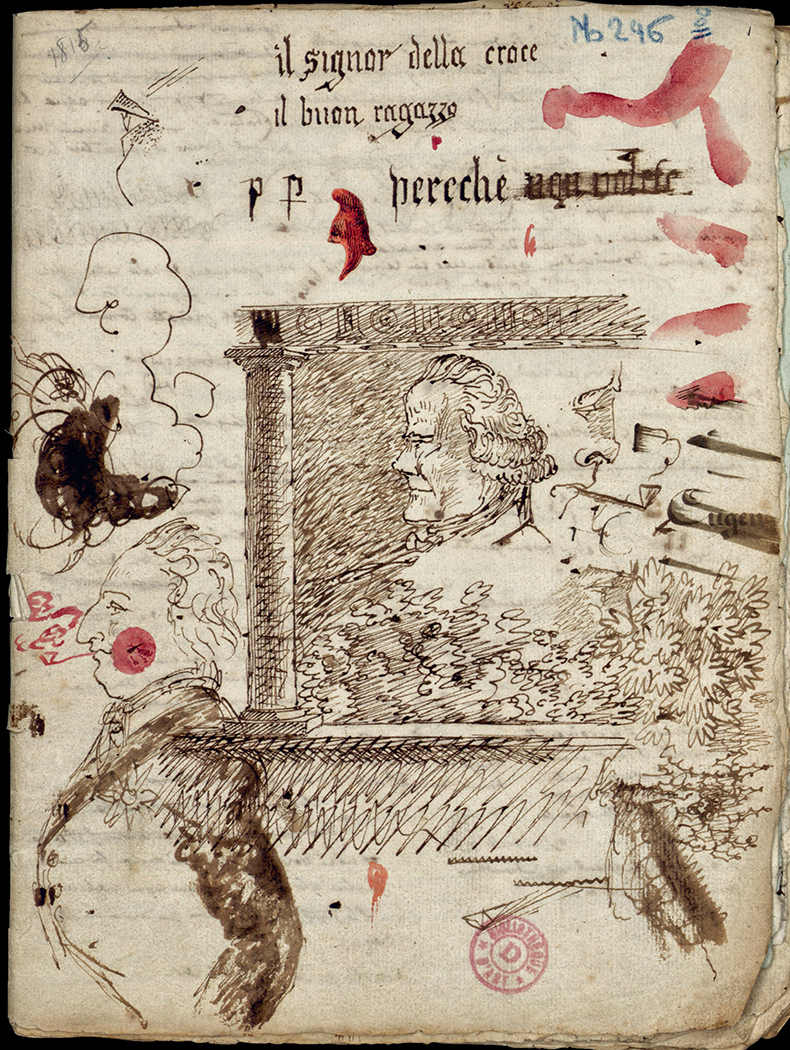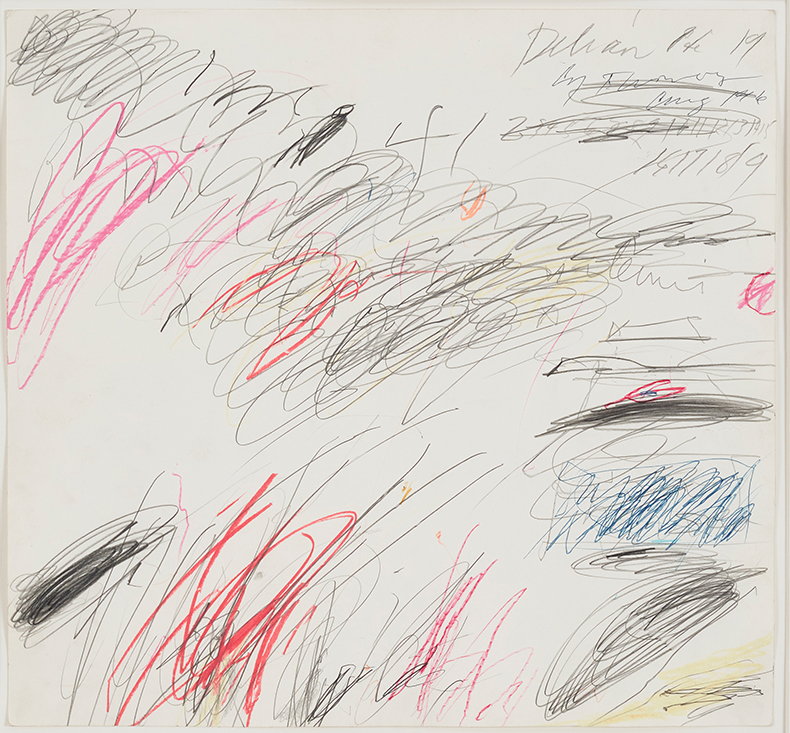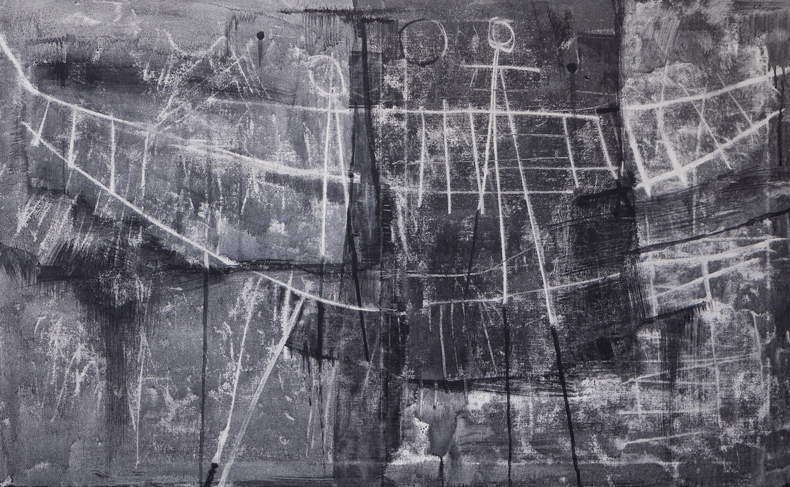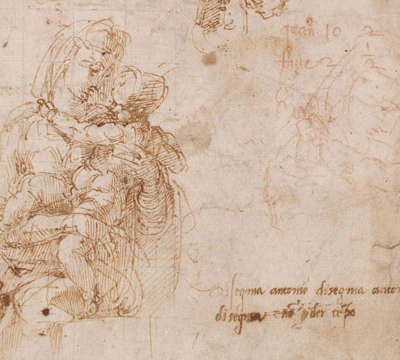Imagine Dubuffet or Basquiat scrawling on the back of a Michelangelo and you get a good idea of the first impressions of a visitor to ‘Gribouillage/Scarabocchio: From Leonardo da Vinci to Cy Twombly’, currently at the Beaux-Arts de Paris. Curated by Francesca Alberti and Diane H. Bodart, the show explores the striking, perhaps even disquieting resemblance between doodles discovered on works by the Renaissance masters and those of modern artists.
This sumptuously presented exhibition maintains an achronological arrangement throughout. The antique cast of a profile carved into a segment of wall from Alberto Giacometti’s Paris studio hangs cheek by jowl, at the entrance, with the drawing of another profile, discovered — along with a profusion of small but intricate sketches — behind a fresco by Benozzo Gozzoli (1471–72). On a nearby partition, works by Cy Twombly (1967) are flanked by Claude Lorrain drafts (1630) and a Delacroix lithograph (1827), its thick borders alive with the artist’s marginalia.
Cahier de classe (1815), Eugène Delacroix. Photo: © INHA

The question that hangs over the entire exhibition is whether the doodles of the past should be interpreted in the light of artistic modernity. In the Renaissance, prevailing wisdom dictated that the hand was the instrument of reason. By contrast, Leonardo da Vinci himself described his sketching technique as componimento inculto – literally, uncultivated compositions. Leonardo advocated letting go; allowing the hand to drift on the page — guided by happenstance or what we would now call the unconscious — until latent figures surface. The finest example of this vagabond style is Stefano della Bella’s 1648 study of a young man falling to his death, seemingly submerged by the swirling scribbles from which he emerges.
Profile of an old man (1481–86), Leonardo da Vinci. Photo: © Beaux-Arts de Paris

The exhibition abounds in variations on Leonardo’s template: André Masson’s surrealist automatic drawings, Robert Breer’s minimalist cartoon, A Man and His Dog Out for Air (1957), or Henri Michaux’s suitably hypnotic pieces produced under the influence of mescaline. Physical constraints are frequently adopted in pursuit of spontaneity: Salvador Dalí drawing while pleasuring himself; Willem de Kooning electing to draw with his left hand or with several pencils at the same time. A film of 1995 shows Robert Morris performing one of his numerous Blind Time compositions. The film finds an echo in Brassaï’s photograph of Henri Matisse from 1939, standing bold upright beside the face he has just scrawled on a door with closed eyes and a piece of chalk, while also calling to mind the spiritualism that inspired Victor Hugo’s ink sketches.
Matisse beside a drawing executed with his eyes shut (1939), Brassaï. © Estate Brassaï Succession/Philippe Ribeyrolles

For Paul Klee, who naturally looms large here, the activities of drawing and writing were identical. Many of the works on display – those of Klee, Giacometti, Masson, Twombly, and Steinberg in particular – conjure up Roland Barthes’ famous essays on the artistic tradition of ‘illegible’ writing, which, he felt, held out the utopian promise of a world free from the tyranny of preordained meaning.
Delian Ode n°19 (1961), Cy Twombly. © Cy Twombly Foundation

But the exhibition also revels in the subversive charge of doodling. The section where Renaissance sketches are presented vertically on counters – allowing you to see the official production on one side and the unofficial on the other – provides the illicit thrill of a peep show. Images are sometimes of a scatological or sexual nature. There are caricatures of cuckolds with outsize horns from the 17th century and photographs of criminals’ tattoos taken by the French police around the Second World War. A diminutive sketch by Michelangelo represents a young man defecating. James Ensor draws a man urinating against a graffitied wall on which someone has scrawled ‘Ensor is mad’! The artistic production of the mentally ill is explored, as well as that of bored office clerks and children. ‘It took me four years to paint like Raphael, but a lifetime to paint like a child,’ said Picasso. Visiting this exhibition, one gets the impression that he was by no means the only one.
Untitled (Matri Dei d.d.d.) (1965), Luigi Pericle

Like its subject matter, ‘Gribouillage’ is an irreverent, provocative and playful show, but it also reaffirms the power that doodles hold over us in the modern era. As George Steiner once remarked, ‘modernity often prefers the sketch to the finished painting’ – both because it gets us closer to the original inspiration of the artist and because it remains unfinished, in the process of becoming.
‘Gribouillage/Scarabocchio: From Leonardo da Vinci to Cy Twombly’ is at the Beaux-Arts de Paris until 30 April.



